Body centered cubic - Study guides, Class notes & Summaries
Looking for the best study guides, study notes and summaries about Body centered cubic? On this page you'll find 92 study documents about Body centered cubic.
Page 2 out of 92 results
Sort by
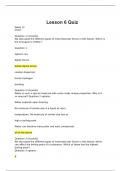
-
CHEM133 Week 13 Lesson 6 Quiz
- Exam (elaborations) • 13 pages • 2023
-
- $22.49
- + learn more
1. Question: We discussed the different types of intermolecular forces in this lesson. Which is the strongest in CF2H2 ? 2. Question: Water is such a special molecule with some really unique properties. Why is it so unusual? 3. Question: We discussed the different types of intermolecular forces in this lesson, which can affect the boiling point of a substance. Which of these has the highest boiling point? 4. Question: If you have 2.00 x 103 J of energy, what mass (g) of solid butane (C4H10O) ...
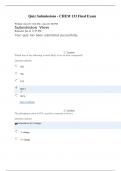
-
CHEM133 Week 16 Final Exam (Spring)
- Exam (elaborations) • 19 pages • 2023
- Available in package deal
-
- $39.99
- + learn more
1. Question: Calculate the lattice energy of NaBr(s), given the following thermochemical equations, where ΔIE and ΔEA are ionization energy and electron affinity, respectively. 2. Question: In which case is the bond polarity incorrect? 3. Question: The phosphorus atom in PCl3 would be expected to have a 4. Question: Which of the following bonds would be the most polar without being considered ionic? 5. Question: Calculate the standard enthalpy of formation (ΔHformation) for LiCl(s) given ...
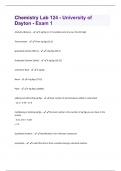
-
Chemistry Lab 124 - University of Dayton - Exam 1 Questions And Answers With Verified Study Solutions
- Exam (elaborations) • 4 pages • 2024
- Available in package deal
-
- $8.39
- + learn more
Analytical Balance - 5 sig figs or 4 if unstable and a line over the 4th digit Thermometer - Three sig figs (20.5) graduated cylinder (50mL) - 3 Sig Figs (50.2) Graduated Cylinder (10mL) - 4 sig figs (10.25) volumetric flask - 5 sig figs Buret - 4 sig figs (27.22) Pipet - 4 sig figs (.02500L) adding and subtracting sig figs - least number of decimal places added or subtracted - 12.2 + 5.44 = 17.6 multiplying or dividing sig figs - the least number is the number of sig figs you can have ...
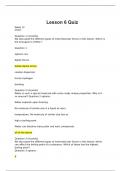
-
CHEM133 Week 13 Lesson 6 Quiz
- Exam (elaborations) • 13 pages • 2023
-
Available in package deal
-
- $32.82
- + learn more
1. Question: We discussed the different types of intermolecular forces in this lesson. Which is the strongest in CF2H2 ? 2. Question: Water is such a special molecule with some really unique properties. Why is it so unusual? 3. Question: We discussed the different types of intermolecular forces in this lesson, which can affect the boiling point of a substance. Which of these has the highest boiling point? 4. Question: If you have 2.00 x 103 J of energy, what mass (g) of solid butane (C4H10O) ...
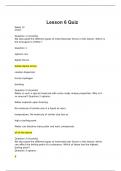
-
CHEM133 Week 13 Lesson 6 Quiz
- Exam (elaborations) • 13 pages • 2023
-
- $21.49
- + learn more
1. Question: We discussed the different types of intermolecular forces in this lesson. Which is the strongest in CF2H2 ? 2. Question: Water is such a special molecule with some really unique properties. Why is it so unusual? 3. Question: We discussed the different types of intermolecular forces in this lesson, which can affect the boiling point of a substance. Which of these has the highest boiling point? 4. Question: If you have 2.00 x 103 J of energy, what mass (g) of solid butane (C4H10O) ...
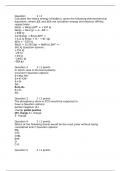
-
CHEM133 Week 16 Final Exam (Summer) Questions and Answers APU
- Exam (elaborations) • 11 pages • 2023
- Available in package deal
-
- $32.99
- + learn more
1. Question: Calculate the lattice energy of NaBr(s), given the following thermochemical equations, where ΔIE and ΔEA are ionization energy and electron affinity, respectively. 2. Question: In which case is the bond polarity incorrect? 3. Question: The phosphorus atom in PCl3 would be expected to have a 4. Question: Which of the following bonds would be the most polar without being considered ionic? 5. Question: Calculate the standard enthalpy of formation (ΔHformation) for LiCl(s) given ...
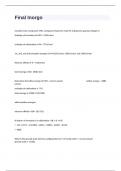
-
Final Inorgo Exam Questions And Complete Correct Answers Graded A+.
- Exam (elaborations) • 20 pages • 2024
-
Available in package deal
-
- $15.49
- + learn more
Consider ionic compound, MX3, composed of generic metal M and generic gaseous halogen X. Enthalpy of formation of MX3 =-701kJ/mol enthalpy of sublimation of M= 177 kJ/mol 1st, 2nd, and 3rd ionization energies of M=625 kJ/mol, 1583 kJ/mol, and 2469 kJ/mol Electron affinity of X =-315kJ/mol bond energy of X2= 183kJ/mol Determine the lattice energy of MX3 - correct answer lattice energy = -4885 kJ/mol enthalpy of sublimation is -701 bo...
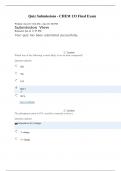
-
CHEM133 Week 16 Final Exam (Spring) Questions and Answers APU
- Exam (elaborations) • 19 pages • 2023
- Available in package deal
-
- $32.99
- + learn more
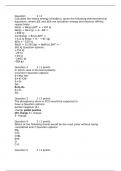
-
CHEM133 Week 16 Final Exam (All Correct)
- Exam (elaborations) • 11 pages • 2023
-
Available in package deal
-
- $35.48
- + learn more
1. Question: Calculate the lattice energy of NaBr(s), given the following thermochemical equations, where ΔIE and ΔEA are ionization energy and electron affinity, respectively. 2. Question: In which case is the bond polarity incorrect? 3. Question: The phosphorus atom in PCl3 would be expected to have a 4. Question: Which of the following bonds would be the most polar without being considered ionic? 5. Question: Calculate the standard enthalpy of formation (ΔHformation) for LiCl(s) given ...
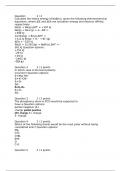
-
CHEM133 Week 16 Final Exam (Summer)
- Exam (elaborations) • 11 pages • 2023
-
- $34.49
- + learn more
1. Question: Calculate the lattice energy of NaBr(s), given the following thermochemical equations, where ΔIE and ΔEA are ionization energy and electron affinity, respectively. 2. Question: In which case is the bond polarity incorrect? 3. Question: The phosphorus atom in PCl3 would be expected to have a 4. Question: Which of the following bonds would be the most polar without being considered ionic? 5. Question: Calculate the standard enthalpy of formation (ΔHformation) for LiCl(s) given ...

That summary you just bought made someone very happy. Also get paid weekly? Sell your study resources on Stuvia! Discover all about earning on Stuvia


